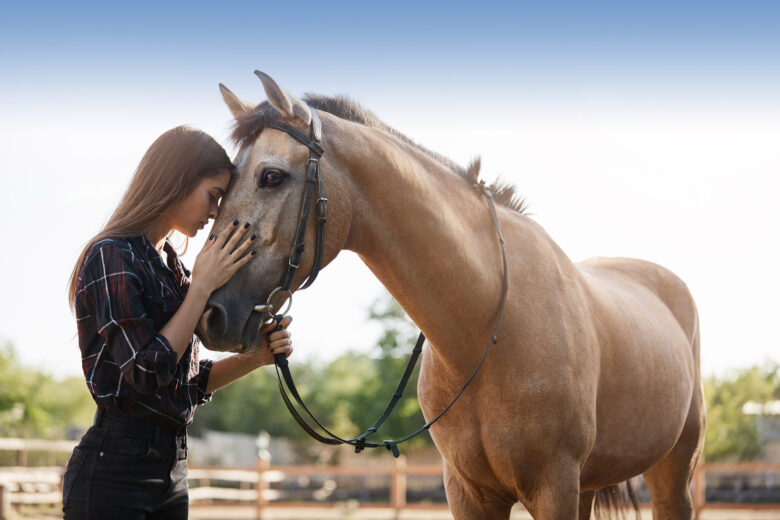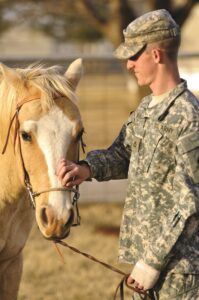Galloping Towards Recovery: Horses as Partners in Rehabilitation
Horses can help rehabilitation in amazing ways. They can improve physical, emotional and cognitive healing. Equine-assisted therapy is a successful way to help individuals recovering from different conditions. Being with these majestic creatures offers a special therapeutic experience. This is something traditional therapies cannot do alone.
Humans and horses have been connected for many centuries. This bond is the basis of equine-assisted therapy, where horses become recovery helpers. Unlike medical facilities, horses add unexpected elements. This means patients must be flexible and take chances. These interactions can show us what we face during our recovery process.
Horseback riding or grooming activities give physical advantages. But equine-assisted therapy also helps emotionally. Horses don’t judge, so people can express themselves without worry. Horses sense human feelings, giving comfort and allowing people to let out their emotions. This connection helps people reflect on themselves and develop.
The power of equine-assisted therapy lies in its unique approach and its ability to help with cognitive challenges. Interacting with horses boosts problem-solving, memory, and decision-making. Doing activities like obstacle courses or grooming tasks exercises the mind. This is especially helpful for people recovering from brain injuries or cognitive issues.
Pro Tip: When doing equine-assisted therapy, trust the process and the horse. Take this chance to grow and let the horse’s intuition guide you on your recovery path.
The healing power of horses in rehabilitation
Working with these animals helps people build trust, balance and coordination. Horseback riding has a calming effect which strengthens muscles and reduces stress. It’s a partnership that brings solace and hope.
Equine-assisted therapy offers more than physical rehabilitation. Horses have an innate understanding of human emotions, providing comfort and companionship. They provide a safe space for individuals to open up, fostering emotional healing and growth.
Science backs the neurological benefits of equine-assisted therapy. AHA’s study shows improved memory, attention and problem-solving skills.
Benefits of equine-assisted therapy
Equine-assisted therapy is a powerful tool for individuals looking to rehabilitate themselves. Its advantages are both physical and emotional.
- Physical Strength: Working with horses strengthens muscles, balance, coordination, and overall fitness.
- Emotional Well-being: Horses’ calming presence reduces stress, relaxes, and boosts moods.
- Social Engagement: Collaborating with horses and therapists helps develop social skills, communication, and trust.
- Self-Confidence: Achieving goals during therapy increases self-esteem and confidence.
On top of these benefits, there is a special bond between humans and horses. This bond can enable emotional healing and help individuals conquer trauma.
Equine-assisted therapy provides a remarkable opportunity to grow, heal, and develop. Don’t miss out on the chance to gallop towards recovery!
How horses provide support in rehabilitative programs
Horses have a special part to play in recovery programs, offering unique advantages. These include:
- Helping people with physical therapy by improving balance, coordination and strength through their movements.
- Stimulating the body’s natural response with the rhythm of the horse’s walk, developing sensory integration and proprioception.
- Helping people build trust, empathy and self-confidence through interaction.
- Creating a safe setting for people to express their feelings and conquer fears.
- Promoting communication and socialization skills by working with others in groups.
- Forcing people to use problem-solving and decision-making skills through tasks.
Equine-assisted therapy also offers an inclusive approach, allowing people with different disabilities to join in. The relationship between horses and humans goes beyond just care. They form strong bonds that improve healing. For instance, Samantha, a young girl with autism, was having problems with socializing. She partook in an equine-assisted therapy program and connected with Bella, a peaceful horse. Over time, she trained herself in non-verbal communication, empathy and patience while brushing Bella. The horse created a caring environment that motivated her to progress.
We know how horses have a powerful effect on rehabilitation programs. They give people strength, resilience and hope.
Case studies and success stories
Horses have a special place in rehabilitation! Many success stories highlight their incredible therapeutic benefits. These tales demonstrate the positive impact horses can have on people seeking recovery.
- For instance, a young girl with cerebral palsy had improved coordination and strength from equine-assisted therapy.
- Also, a military veteran suffering from PTSD found solace and healing through horseback riding.
- Hippotherapy sessions were beneficial for an elderly woman recovering from a stroke.
- Finally, a teenage boy with autism made progress in his social interactions after participating in equine-assisted activities.
These examples show how horses can transform rehabilitation. They have an intuition for understanding human emotions and needs, making them ideal partners.
Keep in mind that everyone’s experience will be different. Have trained professionals for safe and effective sessions!
Challenges and considerations in using horses for rehabilitation
Safety and well-being of the patient and horse are paramount when using horses for rehabilitation. Training and certification of therapists is key for a successful program. To promote therapeutic effects, an environment free of distractions is essential.
Particular attention should be paid to each patient’s unique condition. Allergies or fears related to horses should be considered to ensure a smooth rehabilitation journey.
An inspiring story is that of Jackson, a young boy with cerebral palsy. Jackson found comfort and motivation in therapy horses, leading to improved muscle tone and coordination. His progress brought joy to his family and inspired others.
Horses are extraordinary partners in rehabilitation, offering physical, emotional, and psychological support. Challenges exist, yet the rewards are worth pursuing.
Future possibilities and advancements in equine-assisted therapy
Equine-assisted therapy has incredible possibilities for the future. As tech advances, we may see a mix of horse-riding and virtual reality simulations. This could make sessions more immersive and benefit individuals more.
Research suggests that EAT can do more than just help physically. Studies show potential for tackling mental health issues such as anxiety and depression. With more exploration, horses could be key to helping people with psychological problems.
Advances in EAT might lead to new equipment and tools. Tech like sensors in saddles and biofeedback devices can give therapists info on patients’ progress and help customize treatments.
Conclusion
We’ve looked deep into the impact horses can have in rehab. Their special ability to connect with humans on a profound level offers physical, emotional, and psychological aid. Horses have empathy and intuitiveness, responding to our needs in ways traditional therapy can’t.
Equine-assisted activities are useful for a wide range of conditions. It forms a safe space for healing and growth between horse and human. Horses also offer physical activity, which can help strength and coordination. They provide emotional and comforting support, too.
There’s a lot of versatility in equine-assisted activities. For physical disabilities, riding can improve balance, core strength, and muscle tone. For mental health issues or trauma, horses can create a calming atmosphere.
Studies show how beneficial these activities can be for participants. For example, research by Becker-Blease et al., (2007) found that children who partook in therapeutic horseback riding had better social skills and reduced symptoms of attention-deficit/hyperactivity disorder.
These findings prove the value of horses in rehabilitation and how they can be key partners in recovery.
Frequently Asked Questions
FAQ 1: How can horses be used in rehabilitation?
Horses have been proven to be highly effective in rehabilitation. They offer physical, emotional, and psychological benefits through horseback riding and equine-assisted activities. The movement of the horse stimulates the rider’s muscles, improves balance and coordination, and helps in building core strength.
FAQ 2: Who can benefit from horse-assisted rehabilitation?
Horse-assisted rehabilitation can benefit a wide range of individuals. It is commonly used for people with physical disabilities, neurological disorders, emotional trauma, and mental health conditions. Children, adults, and veterans can all benefit from the therapeutic effects of interacting with horses.
FAQ 3: What are the psychological benefits of horse-assisted therapy?
Horse-assisted therapy promotes emotional well-being by providing a sense of accomplishment, self-confidence, and improved self-esteem. Horses also offer unconditional acceptance, which can be particularly helpful for individuals with trust issues or a history of trauma.
FAQ 4: Do I need horse riding experience to participate in horse-assisted rehabilitation?
No prior horse riding experience is necessary to participate in horse-assisted rehabilitation. Qualified professionals are available to guide and support individuals throughout the therapy sessions. The focus is on the therapeutic interaction with the horse rather than advanced riding skills.
FAQ 5: Are there any safety concerns involved in horse-assisted rehabilitation?
Safety is a top priority in horse-assisted rehabilitation programs. The horses used are well-trained and carefully selected based on their temperament and suitability for therapy. Trained professionals ensure the safety of participants by providing proper instructions and supervision during all activities.
FAQ 6: What outcomes can be expected from horse-assisted rehabilitation?
Horse-assisted rehabilitation can lead to various positive outcomes. These include improved muscle strength and coordination, enhanced emotional well-being, increased self-confidence, improved social skills, and better overall quality of life.



